Fertilizing your indoor bonsai is like giving it a spa treatment—it’s essential for lush growth and vibrant beauty! In spring, I feed every 3 to 6 weeks with nitrogen-rich fertilizer for those lively leaves. Come summer, I switch to a balanced mix monthly, easing off in autumn as winter looms. Recall, young trees crave frequent feedings, while mature ones need less. Curious about how to avoid over-fertilizing and keep your little tree thriving? Let’s explore more!
Quick Takeaways
- Fertilize indoor bonsai every 3 to 6 weeks in spring with a nitrogen-rich formula to promote vigorous growth.
- Use balanced fertilizers during summer as growth intensity may vary, adjusting application frequency accordingly.
- In autumn, reduce fertilization frequency to once a month to prepare bonsai for winter dormancy.
- Young bonsai require more frequent feeding, while mature varieties benefit from less frequent applications tailored to their health.
- Always start with diluted fertilizers and halt feeding 30 days before the bonsai goes dormant to prevent over-fertilization.
Understanding the Growth Cycle of Indoor Bonsai
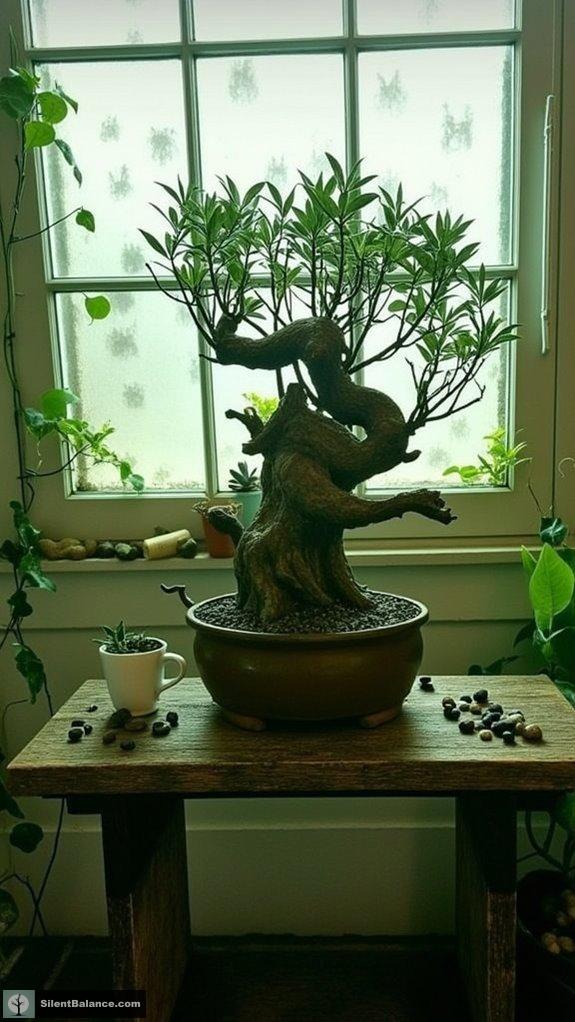
When it comes to understanding the growth cycle of indoor bonsai, it’s a bit like unraveling a beautiful, complex tapestry. Each stage—seedling, early development, and refinement—is like a milestone on this vibrant journey.
Have you ever watched a sapling transform? The early development phase focuses on trunk thickening and branch formation, setting the stage for its future glory. This involves pruning techniques that help manage canopy size and stimulate interior strength. Consistent watering according to the seasonal needs of the bonsai is also crucial for its health.
As we shift into secondary structure, the main branching framework sets up a lively dance of growth and creativity.
But wait, it’s not just about the top! A healthy root ball is essential for vigor.
You see, understanding these stages helps us nurture our little green friends, ensuring they thrive in a cozy indoor environment. Isn’t that just enchanting?
Optimal Fertilization Frequency for Each Season
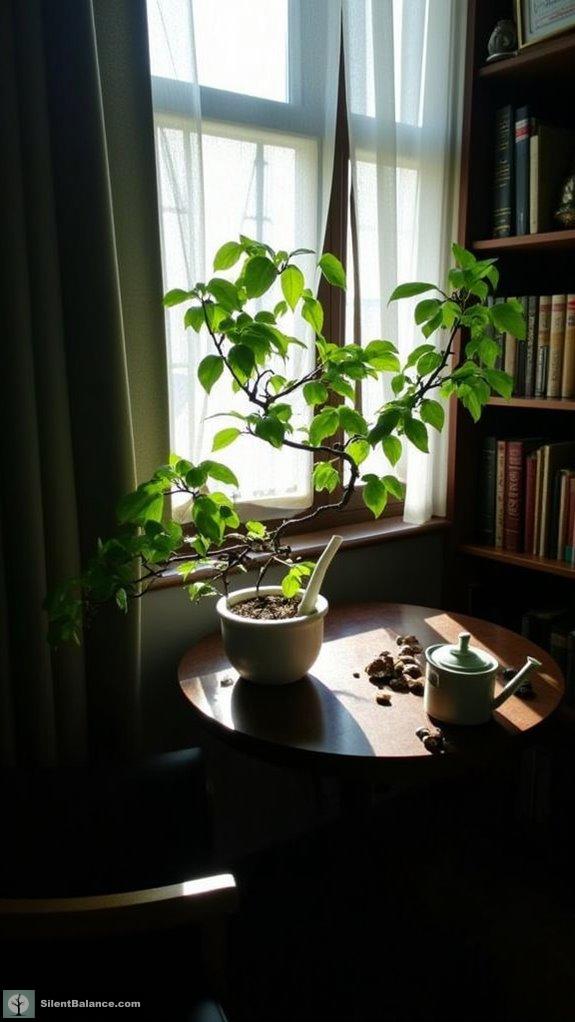
As spring arrives, the excitement of nurturing our indoor bonsai ignites—there’s nothing quite like witnessing those first signs of growth! During spring, I feed my bonsai every 3 to 6 weeks, using fertilizers rich in nitrogen to encourage that fabulous leafy burst. It’s all about supporting those vibrant vibes! Nitrogen promotes leaf and stem growth is crucial during this season to ensure robust development. Additionally, it’s essential to remember that different types of bonsai may require varying levels of nutrients based on their spiritual significance and care methods.
I keep an eye on growth and stop fertilizing about 30 days before summer kicks in, as we don’t want to push our little friends too hard before dormancy. In summer, I switch to a balanced formula and adjust based on their growth intensity.
As autumn approaches, I ease off to once a month, prepping them for their long winter snooze. It’s about listening to their needs—what’s your bonsai telling you?
Types of Fertilizers: What to Use for Indoor Bonsai
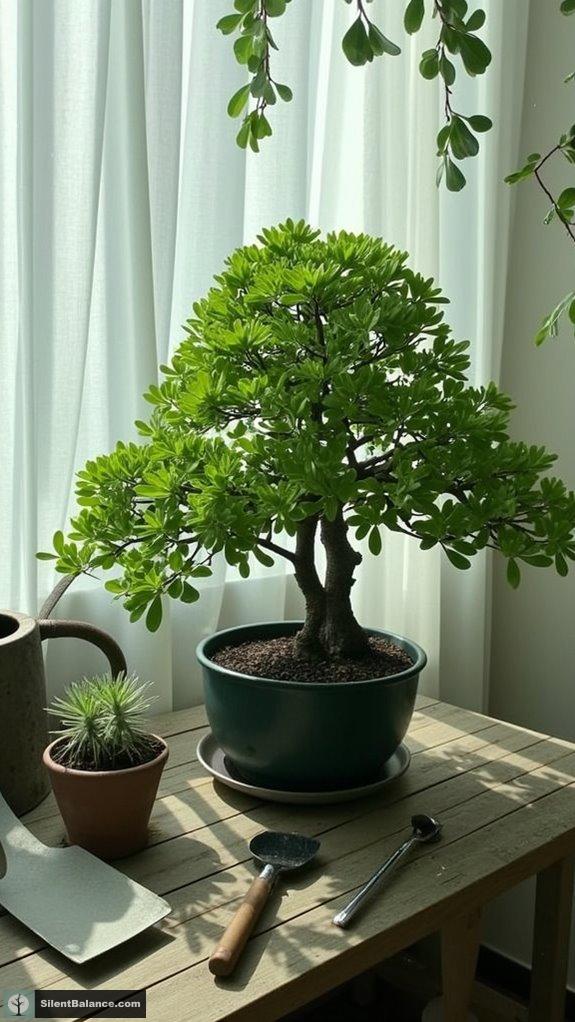
Choosing the right fertilizer for your indoor bonsai isn’t just about grabbing any bottle off the shelf—there’s a whole world of options that can truly elevate your plant game!
Have you tried balanced liquid fertilizers? They’re a staple, perfect for nurturing healthy growth with ratios like 6-6-6.
If your bonsai craves some leafy love, go for higher nitrogen mixes like 7-9-5.
Slow-release fertilizers can be a game-changer, allowing nutrients to seep slowly into your soil—less risk of overfeeding!
And don’t overlook organic options like Biogold, which are like a spa treatment for your soil’s microbiome.
With so many choices, there’s something for every bonsai enthusiast—what’s your favorite go-to?
Tailoring Fertilizer Application to Bonsai Age and Health
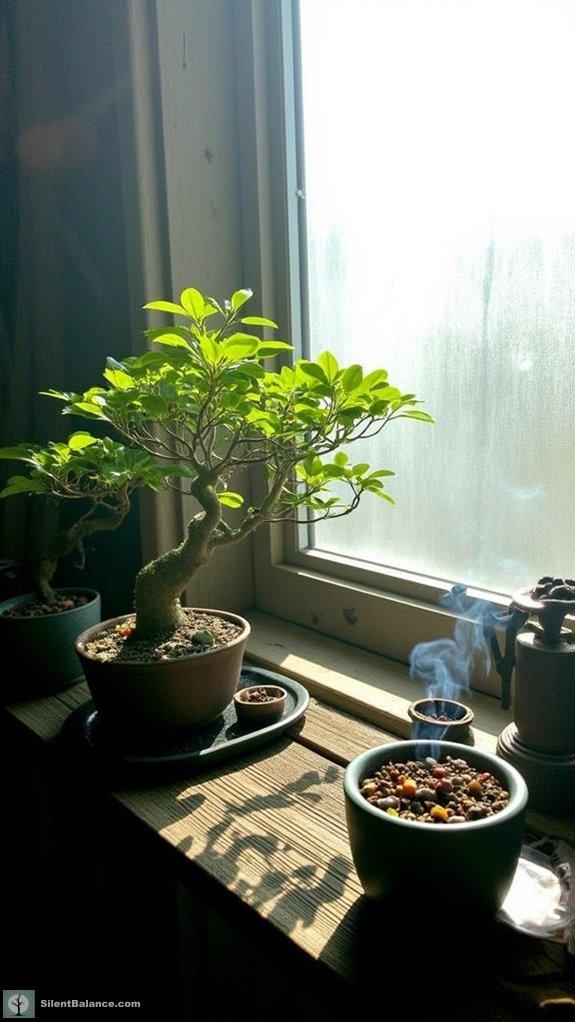
Although you might think that all bonsai are created equal, the truth is that tailoring your fertilizer application to the age and health of your tree can make a world of difference.
For my young bonsai, I’m all about frequent feeding—every 3 to 4 weeks when they’re actively growing. They need that extra boost!
But with mature bonsai, I dial it back. They prefer a quieter approach, receiving nutrients less often as they enjoy their leisurely growth pace.
And let’s not forget, if your tree’s showing signs of stress or disease, it’s time to reduce the dosage. We want to nurture, not overwhelm!
Isn’t it a joy to learn the nuances of this ancient art? Happy fertilizing!
Best Practices for Avoiding Over-Fertilization
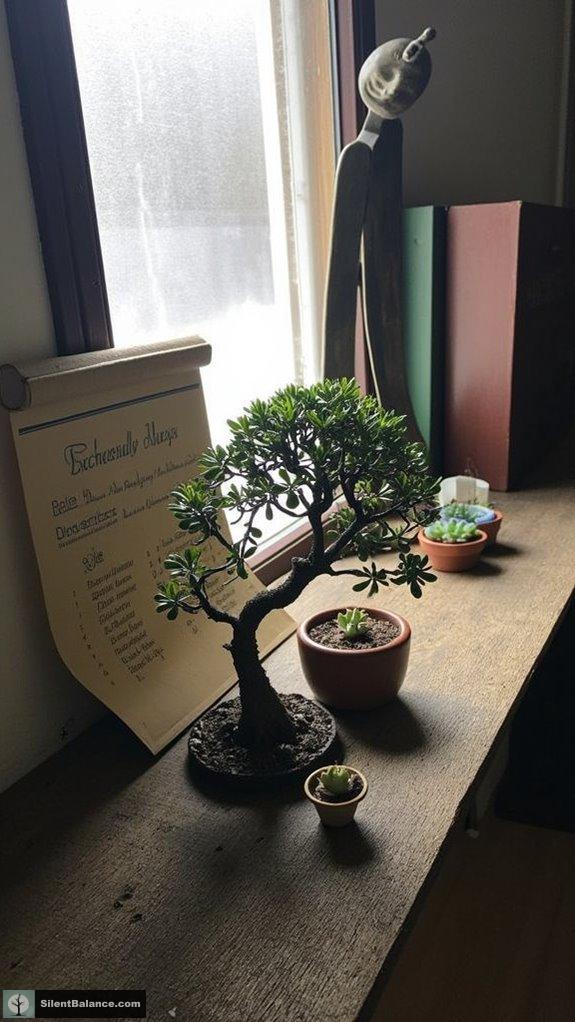
Getting the fertilizer routine just right for your bonsai is a dance—one that requires both finesse and awareness.
To avoid over-fertilization, start by establishing a consistent feeding schedule tailored to your bonsai’s species and growth stage. Keep in mind, during active growth, there’s no need to go crazy—every three to six weeks for liquid feeds is plenty!
I often find it helpful to track applications with a calendar alert because, let’s face it, we overlook things.
When you begin, dilute your fertilizers to half strength, treating your precious tree with care.
And for goodness’ sake, stop fertilizing about 30 days before dormancy. This way, you prevent nutrient buildup and keep your bonsai thriving without stress.
After all, no one wants a bonsai drama on their hands!
Adjusting Nutrient Ratios for Aesthetic Growth Control

When it comes to fine-tuning the nutrient ratios of your bonsai, there’s a thrilling world waiting to be explored.
Ever wondered how a little tweak can transform your tree’s aesthetic?
By upping nitrogen in spring, you can release a burst of lush, vibrant foliage—perfect for those show-stopper vibes.
But as autumn approaches, dialing down that nitrogen lets your bonsai prepare for dormancy, letting its roots soak up the nutrients like a fine wine.
Isn’t it fascinating how adjusting those ratios can shape your tree’s character?
With phosphorus boosting blooms and potassium offering vigor, it’s like giving your bonsai a tailored suit for every season!
Bonsai Tree Symbolism
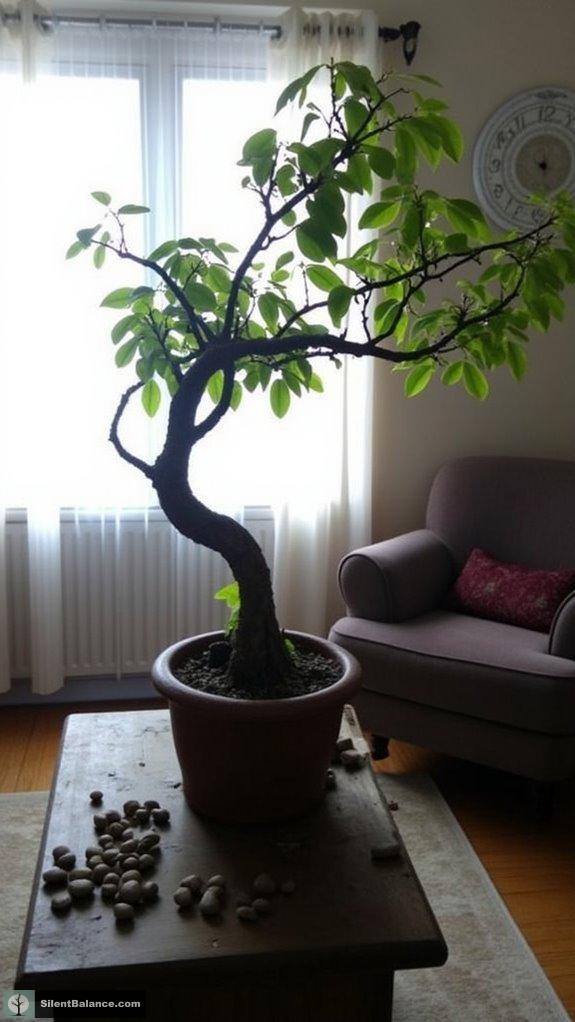
Bonsai trees aren’t just stunning little green masterpieces; they’re packed with symbolism that runs deep, weaving a rich tapestry of history and meaning.
From their roots in ancient Chinese penjing—to the spiritual zen cultivated by Japanese monks—each bonsai carries stories of harmony and balance.
Ever noticed how they seem to whisper patience? Yes! Growing these beauties requires time and tender loving care.
When you gift a bonsai, you’re not just sharing a plant; you’re sending good vibes, peace, and heartfelt wishes.
Imagine someone gazing at their bonsai in quiet contemplation, reflecting on life’s complex connections.
Isn’t it remarkable how this little tree can inspire such profound thoughts while adding tranquility to our spaces? I say, bring on the bonsai magic!
Tree Symbolism
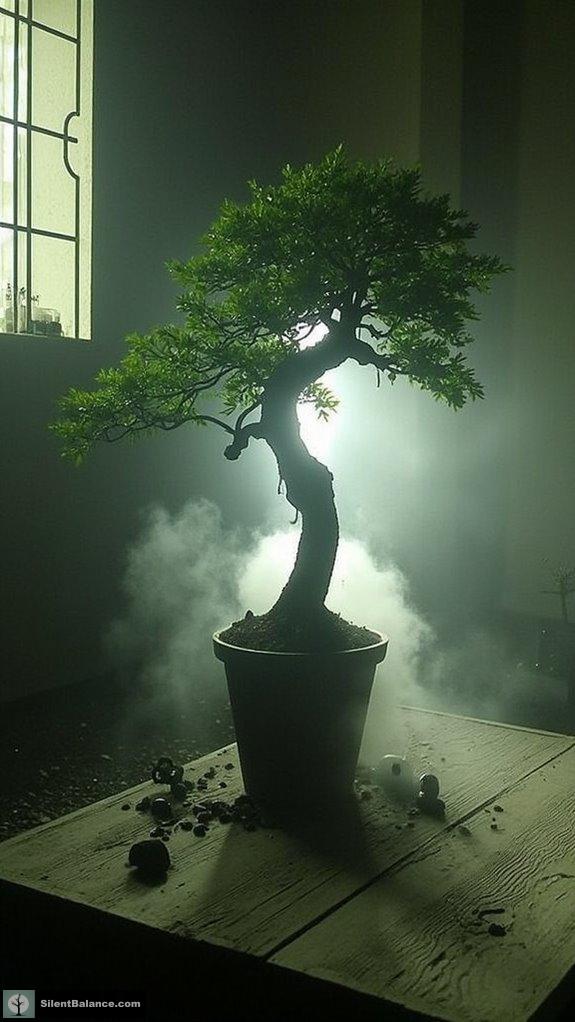
Trees are more than just towering structures of wood and leaves; they’re nature’s storytellers, weaving tales of wisdom, strength, and interconnectedness.
Have you ever thought about the profound symbolism trees carry? Here are a few that truly resonate:
- Cherry Blossom – In Asian cultures, it’s a symbol of fleeting beauty.
- Baobab – This African giant represents strength and community.
- Oak Tree – In Europe, it signifies durability and longevity, just like your bonsai!
- Yggdrasil – The Nordic World Tree connects dimensions, a vibrant reminder of life’s interconnectedness.
Questions and Answers
Can I Use Garden Fertilizers on My Indoor Bonsai?
I wouldn’t use garden fertilizers on my indoor bonsai. They’re too strong and can harm delicate roots. I prefer specially formulated bonsai fertilizers that provide balanced nutrients without the risk of salt buildup. Trust me, they thrive!
How Do I Know if My Bonsai Needs Fertilizer?
When it comes to bonsai care, you wanna keep your eyes peeled. If I notice pale leaves, slowed growth, or poor root health, I know it’s time to give my bonsai a nutrient boost.
What Signs Indicate Over-Fertilization in Bonsai?
I’ve noticed yellowing leaves, browning tips, and that crusty soil surface—it’s clear signs I’ve over-fertilized my bonsai. If you’re seeing these, it’s essential to scale back and give those roots a break!
Should I Use Liquid or Granular Fertilizers for Indoor Bonsai?
I love watching my bonsai thrive, and I find that liquid fertilizers give an immediate boost when it needs it most. However, I also appreciate the steady support that granular fertilizers offer during quieter months.
How Does Indoor Lighting Affect Bonsai Fertilization Needs?
I’ve noticed that my bonsai’s light conditions really shape its fertilization needs. With ample light, it thrives and demands more nutrients. But if the light’s low, I cut back to keep it healthy.
References
- https://bonsai-tools.muragon.com/entry/468.html
- https://www.bonsaioutlet.com/basics-of-bonsai-fertilizing/
- https://www.bonsaiable.com/blog/how-to-fertilize-bonsai-trees
- https://www.bonsaiempire.com/basics/bonsai-care/fertilizing
- https://bonsai4me.com/fertilising-your-bonsai-bonsai-feeds/
- https://bonsaimirai.com/blog/pinching-vs-pruning
- https://www.mistralbonsai.com/en/pine-bonsai-trees-of-1-or-2-growth-stages/
- https://www.bonsaiempire.com/basics/general/calendar
- https://www.bonsaiable.com/blog/bonsai-tree-growth-stages
- https://www.evergreengardenworks.com/dormancy.htm
- https://thebonsaisupply.com/pages/watering-feeding-bonsai-trees
- https://www.youtube.com/watch?v=UQHkLkl6PkE
- https://www.bonsaiboy.com/catalog/indoorbonsaicare.html
- https://treecarezone.com/best-bonsai-fertilizers/
- https://www.bonsaiempire.com/forum/watering-and-fertilizing/21590-fertilisers-research-and-deep-dive
- https://easternleaf.com/bonsai-fertilizers-s/142.htm
- https://www.bonsainut.com/threads/fertilizing-indoor-bonsai.36752/
- https://treehousebonsai.com/blogs/bonsai-profesionnal-blog/bonsai-fertilizer-a-overview-calendar
- https://bonsaitonight.com/2016/12/13/how-to-fertilize-bonsai/
- https://www.bonsaioutlet.com/fertilizer-usage-amounts/
- Perfect Pots for Thriving Tropical Bonsai Tree Containers - September 5, 2025
- Top 10 Bonsai Tree Designs for Miniature Home Greenery - September 5, 2025
- What Are the Easiest Bonsai Tree Species for Minimal Care? - September 5, 2025

